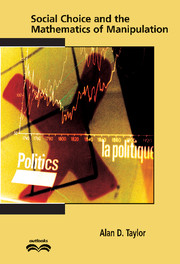1 - An Introduction to Social Choice Theory
Published online by Cambridge University Press: 07 December 2009
Summary
Some Intuitions, Terminology, and an Example
In a capitalist democracy there are, according to Nobel Laureate Kenneth J. Arrow (Arrow, 1950), “essentially two ways by which social choices can be made: voting, typically used to make ‘political’ decisions, and the market mechanism, typically used to make ‘economic’ decisions.” Our concern here is exclusively with the former.
Thus, for us, democratic theory is, in the words of Peter C. Fishburn (Fishburn, 1973, p. 3), “based on the premise that the resolution of a matter of social policy, group choice, or collective action should be based on the preferences of the individuals in the society, group, or collective.” And social choice theory is, as William H. Riker put it (Riker, 1986, p. xi), “the description and analysis of the way that the preferences of individual members of a group are amalgamated into a decision of the group as a whole.” Arrow, by the way, is an economist, Fishburn a mathematician, and Riker a political scientist.
Let's start with a very simple example. Suppose we have an academic department with ten faculty members, one of whom is serving as chair. They are in the process of filling a position in the department and have interviewed five finalists for the job. Needless to say, the different department members disagree on the ranking of the five, and what is needed is some procedure for passing from the preferences of the individuals in the department to the “preferences,” if you will, of the group.
- Type
- Chapter
- Information
- Social Choice and the Mathematics of Manipulation , pp. 3 - 36Publisher: Cambridge University PressPrint publication year: 2005



